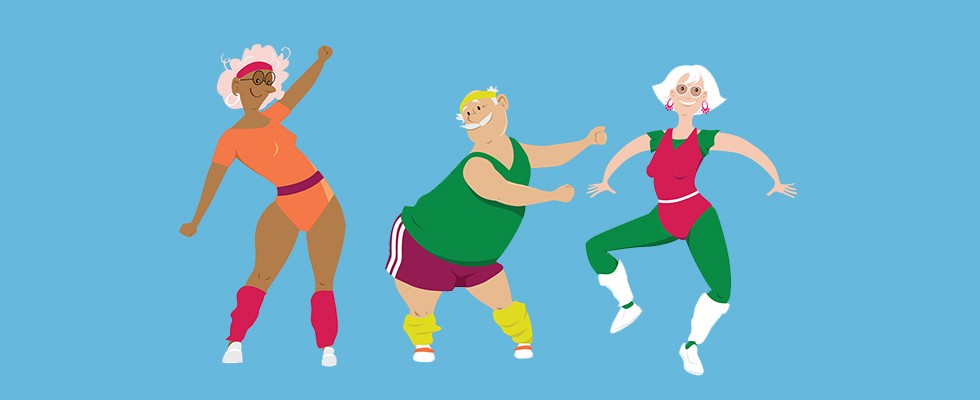
As more and more people are looking to work out at home, it’s essential to consider the needs of people with mobility limitations. There are multiple options for adaptive technologies, virtual programming and equipment that can be used to create accessible home workouts for seniors and others with disabilities. With minimal effort, a combination of these low-cost resources can be used to create an inclusive fitness environment for anyone to get exercise in the comfort of their own home, making homecare fitness options more equitable both financially and for those who have mobility challenges.
According to the Centers for Disease Control and Prevention (CDC), regular physical activity can help improve the overall health and function of older adults, including reducing the risk of chronic diseases such as heart disease, diabetes and depression. These benefits are why it is important to ensure all aging people have access to a fitness routine that works for them.
Popular Adaptive Technologies for Home Fitness
Many old and new technologies can be used or adapted to make home fitness routines more available to people of all mobility levels, seniors and otherwise.
1. Resistance Bands
These are one of the most popular adaptive technologies for home workouts. The large rubber bands come in various strengths and can be used to work on strength training, balance and flexibility. Resistance bands can be easily adjusted to accommodate different levels of ability and can be used for a wide range of exercises, from upper- to lower-body workouts. Studies have shown that resistance training, specifically, can help improve muscle strength and function in older adults, which can reduce the risk of falls and improve overall mobility.
2. Exercise Balls
These balls come in many sizes and can be used for a wide range of exercises, including core strengthening, balance and stability. They can also be used for seated exercises, making them an excellent option for those who have difficulty standing for long periods of time. Exercise balls are shown to be effective in helping older adults improve balance and stability, which can reduce the risk of falls and improve overall mobility.
3. Seated Exercise Equipment
Great for those who have difficulty standing, these machines provide a low-impact workout and can be used for various exercises, including arm and leg presses, leg curls and more. They are also equipped with adjustable resistance levels, which makes them suitable for people of all fitness levels.
4. Adaptive Yoga Equipment
Those who are looking for a full-body workout can investigate adaptive yoga equipment. These products include yoga blocks, straps and other tools that can be used to modify poses and make them more accessible for people with disabilities. Adaptive yoga classes are also available online, which can be accessed from the comfort of your own home. Adaptive yoga has been shown to improve flexibility, balance and overall well-being in older adults and individuals with disabilities.
5. Adaptive Cycling Equipment
These cycling adaptations can provide a low-impact cardiovascular workout suitable for older adults and individuals with disabilities.
6. Mini Trampolines
Most people would not think that a trampoline could be an excellent exercise for older adults, but trending rebound products are proving them wrong. These small trampolines allow people to bounce slightly (no big jumps required) to help them improve their balance and stay active.
According to a study by the National Institute on Aging, regular physical activity can help older adults maintain their independence and ability to perform daily activities. The CDC says older adults should aim for at least 150 minutes of moderate-intensity aerobic activity or 75 minutes of vigorous-intensity aerobic activity per week. Staying motivated to reach these goals can be hard if you’re homebound.
Finding Supportive Virtual Fitness Communities
Whether you have a smartwatch that allows you to compete in challenges with your friends or use Strava to share your sports successes, it’s becoming clear that tracking athletic performance is becoming gamified. And why shouldn’t it be? Isn’t that a fun way to share your wins with others?
Ways to share your fitness wins—be it a marathon or a virtual accomplishment marker—with others are an important part of staying accountable for your fitness goals. Those with limited mobility can use smartwatches or step trackers to track goals and accomplishments using some of these common apps, but it’s also important to find groups to motivate them to keep up with regular physical activity.
Now, there are multiple virtual fitness programs customized for older adults that include adaptations for mobility for the whole group, or whose instructors demonstrate modifications for those who require them. These programs can often be found through regional sports centers such as the local YMCA or through health insurance plans with virtual programming that may be available through SilverSneakers.
For those looking for interactive fitness classes available around the clock that are custom designed for older adults, look no further than fitness on GetSetUp, which focuses on core, strength and balance in classes featuring weight training, tai chi, yoga and more.
In conclusion, there are many adaptive technologies and equipment available to create accessible home workouts for seniors and others with disabilities, and virtual classes to help people find a community to support them in their fitness journey.
As a homecare business, it’s important to consider the needs of individuals with mobility limitations and offer products that can help them maintain an active and healthy lifestyle in a community that empowers them to thrive.
